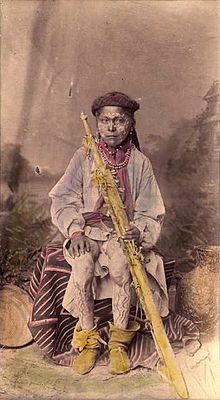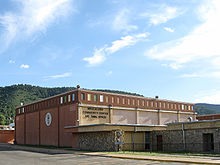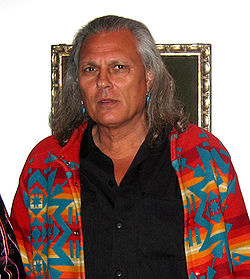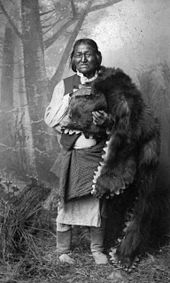- Mescalero
-
This article is about the Native American tribe. For other uses, see Mescalero (disambiguation).
Mescalero Apache Total population 3,156 Regions with significant populations  United States (New Mexico)
United States (New Mexico) Mexico (Sonora)
Mexico (Sonora)Languages Religion Indigenous Religion, Christianity
Related ethnic groups Western Apache, San Carlos Apache, White Mountain Apache
Mescalero (or Mescalero Apache) is an Apache tribe of Southern Athabaskan Native Americans. The tribe is federally recognized as the Mescalero Apache Tribe of the Mescalero Apache Reservation in southcentral New Mexico. In the nineteenth century, the Mescalero opened their reservation to other Apache bands, such as the Chiricahua who had been imprisoned in Florida, and the Lipan Apache.
Contents
Reservation
 Mescalero tipis.
Mescalero tipis.
Originally established on May 27, 1873,[1] by Executive Order of President Ulysses S. Grant, the reservation was first located near Fort Stanton. The present reservation was established in 1883. It has a land area of 1,862.463 km² (719.101 sq mi), almost entirely in Otero County. A small unpopulated section is in Lincoln County just southwest of the city of Ruidoso. The reservation had a 2000 census population of 3,156. It is located at geographical coordinates 33°10′42″N 105°36′44″W / 33.17833°N 105.61222°W .
Ranching and tourism are major sources of income for the people. U.S. Route 70 is the major highway through this reservation, which lies on the eastern flank of the Sacramento Mountains and borders the Lincoln National Forest. The mountains and foothills are forested with pines, and commercial development is restricted. The tribe has invested in appropriate development, for example, a ski resort called Ski Apache, on a 12,000-foot (3,700 m) mountain, Sierra Blanca. They also constructed a related hotel and casino for tourist traffic, the Inn of the Mountain Gods Resort and Casino.
Sierra Blanca is sacred ground for the Apache. The Mescalero built a cultural center near the tribal headquarters on U.S. Route 70 in the reservation's largest community of Mescalero. It displays historical information and artifacts of the tribe. The tribe has another, larger museum on the western flank of the Sacramento Mountains in Dog Canyon, south of Alamogordo.
Tribal organization
The Mescalero Apache Tribe holds elections for the office of president every two years. The eight Tribal Council members also are elected for two years. Election for the Council is held every year, when one half of the members are up for reelection.
In 1959, the tribe elected Virginia Klinekole as its first woman president.[2] She later was elected to the Tribal Council, serving on it until 1986.[3] The tribe repeatedly re-elected Wendell Chino as president; he served a total of 43 years, until his death on November 4, 1998.
Soon after Chino's death, the late Sara Misquez was elected as president. Wendell's son, Mark Chino, also has been elected as president. On January 11, 2008 Carleton Naiche-Palmer was sworn in as the new president of the Mescalero Apache tribe.[4]
Culture and language
The Mescalero language is a Southern Athabaskan language which is a subfamily of the Athabaskan and Dené–Yeniseian families. Mescalero is part of the southwestern branch of this subfamily; it is very closely related to Chiricahua, and more distantly related to Western Apache. These are considered the three dialects of Apachean. Although Navajo is a related Southern Athabaskan language, its language and culture are considered distinct from those of the Apache.
Origin of name
The Mescalero's autonym, or name for themselves, is Shis-Inday ("People of the Mountain Forests") or Inday / Indee ("The People"). Neighboring Apache bands called the Mescalero Nadahéndé ("People of the Mescal"), because the mescal agave (Agave parryi) was a staple food source for them. In times of need and hunger, they depended on and survived because of stored mescal.
Bands
 Mescalero painted boy, photo entitled Long Walk of the Navajo. The people were marched over 350-mile (560 km) during the winter of 1864 and incarcerated at Bosque Redondo, New Mexico with the Mescalero Apache.
Mescalero painted boy, photo entitled Long Walk of the Navajo. The people were marched over 350-mile (560 km) during the winter of 1864 and incarcerated at Bosque Redondo, New Mexico with the Mescalero Apache.
- Natahéndé (Spanish rendering as Natages, spelled Na-ta-hay, "Mescal People"; lived between Rio Grande and Pecos River in central New Mexico, with local groups wandering on the southern and western edge of the Llano Estacado onto the southern Texas Panhandle)
- Guhlkahéndé (Spanish rendering as Cuelcajenne, "People of the Plains"; lived east of the mountains and the Pecos River, on the High Plains from the Texas Panhandle to the Pecos Valley, between Amarillo, Tucumcari, Lubbock and the Llano Estacado, along the Sandia and Tijeras Mountains westward to Santa Fe, from Nogal Canyon to the north to Las Vegas, from the Organ Mountains eastwards to El Paso. In Oklahoma (Indian Territory) they developed kinship ties by marriage with the Comanche.)
- Dzithinahndé / Tsilnihéndé (Spanish rendering as Chilpaines, "Mountain Ridge Band People", lived in the mountains west and south of the Pecos River, extending in northern Chihuahua and Coahuila of present-day Mexico.)
- Ch'laandé / Tslahahéndé ("Antelope Band People"; lived west of the Pecos west to the Rio Grande in the mountains of central and south New Mexico and the Tularosa Basin)
- Nit'ahéndé ("People Who Live Against the Mountains", "Earth Crevine (Deer) People"; lived in the Sacramento Mountains in New Mexico and the Guadalupe Mountains in western Texas)
- Tsehitcihéndé ("People of Hook Nose", several bands, who lived in the Guadalupe Mountains, the adjacent Plains of Texas and in northern Coahuila and Chihuahua of Mexico)
- Tsebekinéndé ("Rock House People", often called by Spanish and Americans Aguas Nuevas or Norteños, have had their center around Nuevo Casas Grandes in Chihuahua, migrating north toward the Sacramento Mountains and south to Agua Nueva 60 miles north of Chihuahua City, also on both sides of the Rio Grande between El Paso and Ojinaga, Chihuahua; some local groups lived in the Guadalupe and Limpia Mountains)
- Tahuundé / Tá'huú'ndé ("Mountains Extending into the River People", lived on both sides of the Pecos River in southern New Mexico and into southwestern Texas)
- Tuintsundé ("Big Water People", once the Tú sis Ndé band of the Lipan, who lived in southcentral Texas and in northern Coahuila, camping with several bands of the Mescalero together on the Plains for hunting and raiding; they merged with the Mescalero, forming a Mescalero band)
- Tuetinini ("No Water People", "Tough People of the Desert", once the Tú é diné Ndé band of the Lipan, who had territory in northern Coahuila and Chihuahua, and eventually merged with some southern Mescalero bands)
When many Mescalero bands were displaced by the enemy Comanche from the Southern Plains in northern and central Texas between 1700–1750, they took refuge in the mountains of New Mexico, western Texas, and Coahuila and Chihuahua in Mexico. Some southern Mescalero bands, together with Lipan, lived in the Bolsón de Mapimí, moving between the Nazas River, the Conchos River and the Rio Grande to the north. The Natahéndé had had a considerable influence on the decision-making of some bands of the Western Lipan in the 18th century, especially on the Tindi Ndé, Tcha shka-ózhäye, Tú é diné Ndé and Tú sis Ndé. To fight their common enemy, the Comanche, and to protect the northeastern and eastern border of the Apacheria against the Comancheria, the Mescalero (Natahéndé and Guhlkahéndé) on the Plains joined forces with their Lipan kin (Cuelcahen Ndé, Te'l kóndahä, Ndáwe qóhä and Shá i`a Nde) to the east and south of them.
In August 1912, by an act of the U.S. Congress, the surviving members of the Chiricahua tribe were released from their prisoner of war status. They were given the choice to remain at Fort Sill or to relocate to the Mescalero reservation. One hundred and eighty-three elected to go to New Mexico, while seventy-eight remained in Oklahoma.[5] Their descendants still reside in both places.
Notable Mescalero
Historical chiefs and headmen
- Gomez (Chief of a Mescalero band in the Davis Mountains before the Civil War)
- Espejo (Chief of a Mescalro band in the Plains east of the Davis Mountains, late 1860)
- Alsate (Arzate, Arzatti, ca. *1817 - †1880, last Chief of the Chisos Apaches (also Chinati or Rio Grande Apaches), a Mescalero band in the Davis Mountains, Chisos Mountains and Chinati Mountains[6] in the Big Bend area, the Sierra del Carmen of Coahuila and Sierra Alamos in Chihuahua north of the Bolsón de Mapimí,[7] was caught and executed in Presidio del Norte, his people were sold into slavery in Mexico, late 1860 - 1880)[8]
- Nautzili (="buffalo", also known as Natzili, Chief of the Guhlkahéndé, moved to reservation in 1876)
- Nicolas (Chief)
- San Juan (Chief)
- Santana (War Chief of the Sierra Blanca Mescalero, living in the Sierra Blanca Mountains in south-central New Mexico, †1875)
- Cadette (in Apache: Zhee-es-not-son, Chief)
- Gian-na-tah (War Chief)
- Kutbhalla (War Chief)
Other notable Mescalero
- Gouyen (ca. 1857-1903), female warrior
- Michael Horse, actor, painter
- Wendell Chino, former tribal president of the Mescalero Apache Tribe for 43 years[9]
- Virginia Klinekole, first female tribal president
- Sara Misquez, former tribal president
See also
- Lincoln National Forest
- List of Indian reservations in the United States
- Mescalero, New Mexico
- Mescalero language
- Winnetou
- Mescalero Escarpment
Notes
- ^ Banks, Phyllis (2002). "Bent and Mescalero — home of the Mescalero Apache". southernnewmexico.com. Archived from the original on 2006-11-15. http://web.archive.org/web/20061115173941/http://southernnewmexico.com/Articles/Southeast/Otero/BentandMescalero.html. Retrieved 2006-12-01.
- ^ "Miscellany, Feb. 9, 1959", Time Magazine, February 1959, accessed 1 August 2011
- ^ "Obituary of Virginia Shanta Klinekole", LaGrone Funeral Chapel of Ruidoso Website, accessed 1 August 2011
- ^ Stallings, Dianne (2008-01-17). "New Mescalero Apache tribal officers take oaths". Alamogordo Daily News.
- ^ Debo p.447-8
- ^ ´chinati´ derives from the Apache word ch'íná'itíh, which means gate or mountain pass
- ^ http://redalyc.uaemex.mx/pdf/137/13709207.pdf Documtentos de la genealogía y la vida de Alsate, Jefe de los Apaches de los Chisos
- ^ [Dan L. Thrapp: Encyclopedia of Frontier Biography, Volume 1: A-F, University of Nebraska Press (August 1, 1991), ISBN 978-0803294189, p 18-19]
- ^ Encyclopedia of World Biography: Wendell Chino
References
- Debo, Angie, Geronimo: The Man, His Time, His Place, Norman, OK: University of Oklahoma Press (1976), ISBN 0806118288
- Farrer, Claire R. Thunder Rides a Black Horse: Mescalero Apaches and the Mythic Present. Waveland Press, 1996. ISBN 0881338974
- New York Times, February 6, 2005, section 5, pp. 7, 14.
- United States Census Bureau. Mescalero Reservation, New Mexico
Bibliography
- Castetter, Edward F.; & Opler, Morris E. (1936). The ethnobiology of the Chiricahua and Mescalero Apache: The use of plants for foods, beverages and narcotics. Ethnobiological studies in the American Southwest, (Vol. 3); Biological series (Vol. 4, No. 5); Bulletin, University of New Mexico, whole, (No. 297). Albuquerque: University of New Mexico Press.
- Debo, Angie, Geronimo: The Man, His Time, His Place, Norman, OK: University of Oklahoma Press (1976), ISBN 0806118288
- Hoijer, Harry; & Opler, Morris E. (1938). Chiricahua and Mescalero Apache texts. The University of Chicago publications in anthropology; Linguistic series. Chicago: University of Chicago Press. (Reprinted 1964 by Chicago: University of Chicago Press; in 1970 by Chicago: University of Chicago Press; & in 1980 under H. Hoijer by New York: AMS Press, ISBN 0-404-15783-1).
- Opler, Morris E. (1933). An analysis of Mescalero and Chiricahua Apache social organization in the light of their systems of relationship. Unpublished doctoral dissertation, University of Chicago.
- Opler, Morris E. (1935). The concept of supernatural power among the Chiricahua and Mescalero Apaches. American Anthropologist, 37 (1), 65–70.
- Opler, Morris E. (1936). The kinship systems of the Southern Athabaskan-speaking tribes. American Anthropologist, 38 (4), 620–633.
- Seymour, Deni J. (2002) Conquest and Concealment: After the El Paso Phase on Fort Bliss. Conservation Division, Directorate of Environment, Fort Bliss. Lone Mountain Report 525/528. This document can be obtained by contacting belinda.mollard@us.army.mil.
- Seymour, Deni J. (2003) Protohistoric and Early Historic Temporal Resolution. Conservation Division, Directorate of Environment, Fort Bliss. Lone Mountain Report 560-003. This document can be obtained by contacting belinda.mollard@us.army.mil.
- Seymour, Deni J. (2003) The Cerro Rojo Complex: A Unique Indigenous Assemblage in the El Paso Area and Its Implications For The Early Apache. Proceedings of the XII Jornada Mogollon Conference in 2001. Geo-Marine, El Paso.
- Seymour, Deni J. (2004) A Ranchería in the Gran Apachería: Evidence of Intercultural Interaction at the Cerro Rojo Site. Plains Anthropologist 49(190):153-192.
- Seymour, Deni J. (2004) Before the Spanish Chronicles: Early Apache in the Southern Southwest, pp. 120 –142. In "Ancient and Historic Lifeways in North America’s Rocky Mountains." Proceedings of the 2003 Rocky Mountain Anthropological Conference, Estes Park, Colorado, edited by Robert H. Brunswig and William B. Butler. Department of Anthropology, University of Northern Colorado, Greeley.
- Seymour, Deni J. (2007) Sexually Based War Crimes or Structured Conflict Strategies: An Archaeological Example from the American Southwest. In Texas and Points West: Papers in Honor of John A. Hedrick and Carol P. Hedrick, edited by Regge N. Wiseman, Thomas C. O’Laughlin, and Cordelia T. Snow, pp. 117–134. Papers of the Archaeological Society of New Mexico No. 33. Archaeological Society of New Mexico, Albuquerque.
- Seymour, Deni J. (2007) Apache, Spanish, and Protohistoric Archaeology on Fort Bliss. Conservation Division, Directorate of Environment, Fort Bliss. Lone Mountain Report 560-005. With Tim Church
- Seymour, Deni J. (2007) An Archaeological Perspective on the Hohokam-Pima Continuum. Old Pueblo Archaeology Bulletin No. 51 (December 2007):1-7. (This discusses the early presence of Athapaskans.)
- Seymour, Deni J. (2008) Despoblado or Athapaskan Heartland: A Methodological Perspective on Ancestral Apache Landscape Use in the Safford Area. Chapter 5 in Crossroads of the Southwest: Culture, Ethnicity, and Migration in Arizona's Safford Basin, pp. 121–162, edited by David E. Purcell, Cambridge Scholars Press, New York.
- Seymour, Deni J. (2008) A Pledge of Peace: Evidence of the Cochise-Howard Treaty Campsite. Historical Archaeology 42(4):154-179. With George Robertson.
- Seymour, Deni J. (2008) Apache Plain and Other Plainwares on Apache Sites in the Southern Southwest. In "Serendipity: Papers in Honor of Frances Joan Mathien," edited by R.N. Wiseman, T.C O'Laughlin, C.T. Snow and C. Travis, pp 163–186. Papers of the Archaeological Society of New Mexico No. 34. Archaeological Society of New Mexico, Albuquerque.
- Seymour, Deni J. (2008) Surfing Behind The Wave: A Counterpoint Discussion Relating To “A Ranchería In the Gran Apachería.” Plains Anthropologist 53(206):241-262.
- Seymour, Deni J. (2008) Pre-Differentiation Athapaskans (Proto-Apache) in the 13th and 14th Century Southern Southwest. Chapter in edited volume under preparation. Also paper in the symposium: The Earliest Athapaskans in Southern Southwest: Implications for Migration, organized and chaired by Deni Seymour, Society for American Archaeology, Vancouver.
- Seymour, Deni J. (2009) Evaluating Eyewitness Accounts of Native Peoples along the Coronado Trail from the International Border to Cibola. New Mexico Historical Review 84(3):399-435.
- Seymour, Deni J. (2009) Distinctive Places, Suitable Spaces: Conceptualizing Mobile Group Occupational Duration and Landscape Use. International Journal of Historical Archaeology 13(3): 255-281.
- Seymour, Deni J. (2009) Nineteenth-Century Apache Wickiups: Historically Documented Models for Archaeological Signatures of the Dwellings of Mobile People. Antiquity 83(319):157-164.
- Seymour, Deni J. (2009) Comments On Genetic Data Relating to Athapaskan Migrations: Implications of the Malhi et al. Study for the Apache and Navajo. American Journal of Physical Anthropology 139(3):281-283.
- Seymour, Deni J. (2009) The Cerro Rojo Site (LA 37188)--A Large Mountain-Top Ancestral Apache Site in Southern New Mexico. Digital History Project. New Mexico Office of the State Historian. http://www.newmexicohistory.org/ Select: Place, Communities, Click on 'Cerro Rojo' on the map (orange square-dot NE of EL Paso, East of Las Cruces and Dona Ana ).
- Seymour, Deni J. (2010) Cycles Of Renewal, Transportable Assets: Aspects of the Ancestral Apache Housing Landscape. Accepted at Plains Anthropologist.
- Seymour, Deni J. (2010) Contextual Incongruities, Statistical Outliers, and Anomalies: Targeting Inconspicuous Occupational Events. American Antiquity. (Winter, in press)
External links
Categories:- Mescalero Apache
- Apache tribes
- Native American tribes in New Mexico
- Populated places in Otero County, New Mexico
Wikimedia Foundation. 2010.




